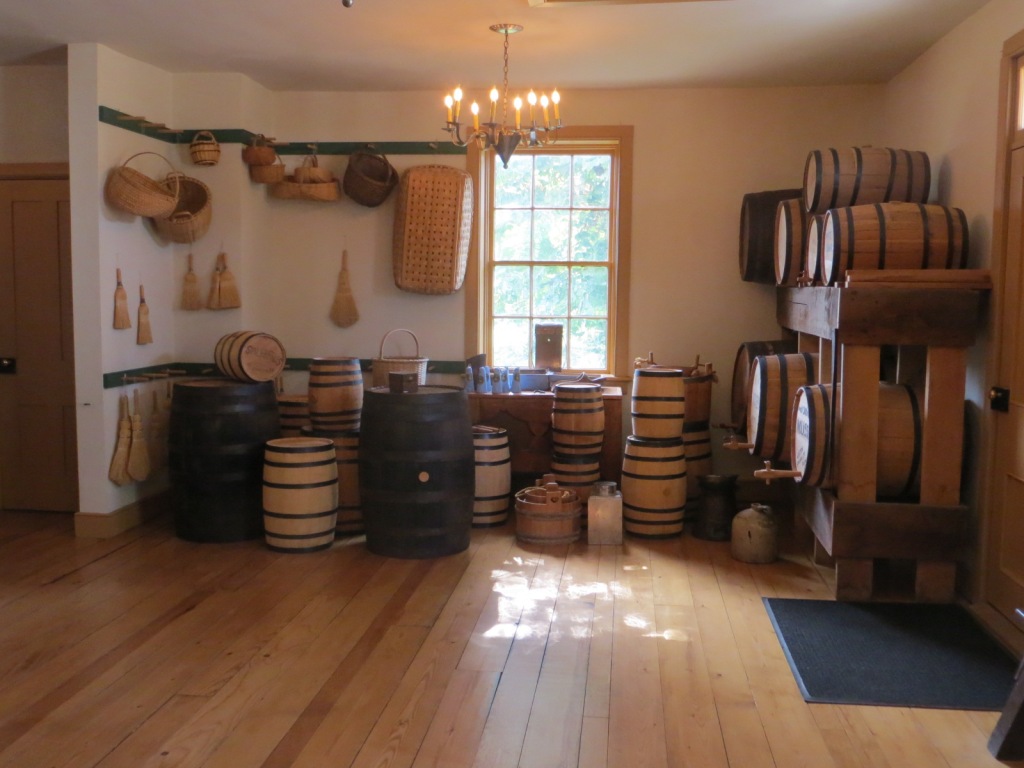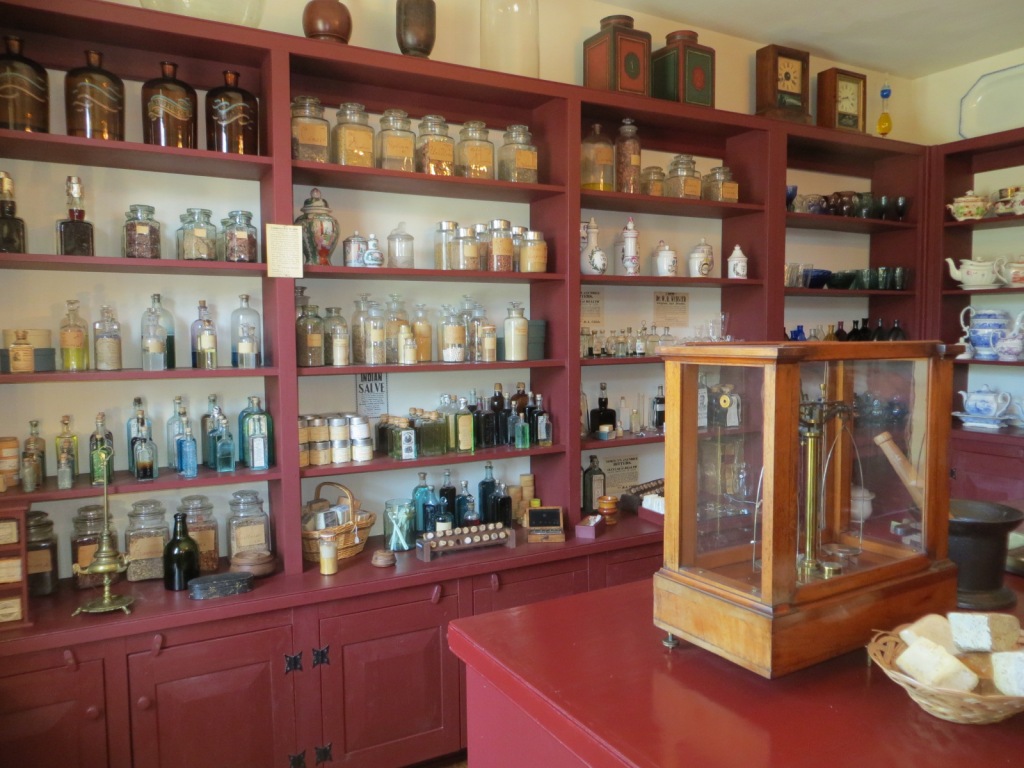When I was growing up, my father had a membership at Old Sturbridge Village in Massachusetts. I don’t know just how often he took us there, but I always enjoyed it, especially visiting the shops of the blacksmith, the potter, and the pewtersmith. As a child I was probably most interested in the process, seeing how iron or clay or molten pewter could turn into horseshoes, pitchers, or spoons. (And in the case of the potter and pewtersmith, how an imperfect product could easily be collapsed back into the raw material and the process started over.)
As an adult, I’m more interested in seeing how people used to live, and how everyday objects could be made with the limited materials and tools available. When I was looking for a place to go for a day or two, I settled on Nauvoo after discovering that the district known as Old Nauvoo had various shops you could visit and learn about their various trades, as well as being the site of significant events for those with an interest in religious history.
I knew a little of the history of Nauvoo from reading historical fiction, but I remembered few details and had no idea just how accurate those were anyway. I didn’t have a particularly strong interest in learning more about Joseph Smith and the religious organization he founded (commonly called the Mormon church but they refer to it as the Church of Jesus Christ of Latter-day Saints), but I had enough curiosity to learn more about it to want to see their free production of “Remembering Joseph” at the Historic Nauvoo Visitors’ Center before beginning to explore Old Nauvoo.
I would guess that the majority of the audience were Latter Day Saints, though I suppose there must be other people like me who go there out of curiosity and for the history. Certainly in the shops in Old Nauvoo and at the Carthage jail the next day, the rest of the people seemed to be family groups, many (most?) of them repeat visitors. Once I was asked by one of the missionaries whether I was a member of the Church, but no one made any effort to engage me in any discussion about my religious views. I thought a couple times of asking, when they spoke of people receiving the “restored Gospel of Jesus Christ,” what was wrong with the one preached before Joseph Smith. But it did not seem to be the time or place to get into that.
I was somewhat disappointed that in most of the shops, nothing was actually being made (as at Old Sturbridge Village, where you could actually buy the products in the gift shop). But you can learn a lot just from seeing examples of products in various stages of completion, with explanations of the work to get from one step to the next. I enjoyed seeing how to make a tin pan, shoes, bricks, a rifle, and wagon wheels. At the print shop I not only saw how a newspaper was produced using movable type but also heard the origin of words and phrases such as upper- and lowercase (from the position of the cases holding these letters) and “minding your p’s and q’s” (which were next to each other in the case and could easily be mixed up since they were mirror images of each other).
At each shop, the missionaries (always two of them, who took turns explaining things) also told about the people who had owned and worked in these businesses, usually including how they had come to join the Church of Jesus Christ of Latter-day Saints, and how they had shown their faith in how they lived, and sometimes in something they had written (such as a letter or diary). Always the portraits they provided of these long-ago Saints were of exemplary faith and behavior. I couldn’t help wondering, did they pick and choose from the stories that could have been told to find only those that showed these people in the best light, or did they only choose to restore buildings that had been the property of the saintliest Saints?
One shop I particularly enjoyed was the Webb Brothers Blacksmith & Wainwright Shop. In the blacksmith side, we were shown how horseshoes were made (though the one he made seemed to be a scaled down model of one, a memento for a tourist to take home rather than a practical shoe that could go on a horse’s hoof). He also explained why not only the horses but also the oxen needed shoes (I had never heard of ox shoes before). But what I found even more interesting was the wainwright side of the shop, where he showed how the large wagon wheels were made, why the rear wheels were larger than the front wheels, and other features of the wagons that were made by the thousands for the planned exodus to the West.

Leaving the wainwright’s shop, I followed the Trail of Hope down to the bank of the Mississippi, reading the signs posted at intervals with words written by people who had left Nauvoo, telling about their experiences of suffering and loss. I may not understand or agree with their religious beliefs, but they certainly showed dedication to and faith in their Church and their leaders as they left nearly everything behind and headed out into unknown dangers.
Reaching the river, I was distracted from serious thoughts about history by seeing a huge area of lilies and lily pads along the river bank. (The next day, driving home on the other side of the river, I saw expanses of lily pads there were if anything even larger.) I’ve seen lily pads before, but in ponds, not rivers, and I’m not sure I had ever seen such big ones as these. I’m curious what makes them proliferate in certain places along the river and not others, but so far I haven’t found anything much about it in my online searches.

My last stop in Old Nauvoo was the Lyon Home and Drug and Variety Store. I remember the General Store at Old Sturbridge Village, so it wasn’t too surprising to see a store that sold baskets, barrels, fabric, dishes, and other household items. But I was somewhat surprised that this was also the drug store. (Though now that I think about it, I remember buying school supplies at the drug store when I was growing up, as well as wishing I had money to buy some decorative items such as a really pretty flower pot that I admired every time I was there.)



I was interested to learn that many of the herbs sold there came from the garden outside, so I wandered out there for a while, but unfortunately none of the plants are labeled. I thought this one might be some kind of pepper (I remembered hearing the missionary mention capsicum), but my iPhone plant identifier guesses either groundcherry or squash.
I don’t think it looks like squash, but I did find gourds elsewhere in the garden. There was a trellis of some kind in the back, and I walked up to it to see what was inside, and was surprised to see a number of large green objects hanging from the top and sides. Looking more closely I realized they were gourds, and I wondered why they were hung there. Then I looked even closer, and realized there were growing there. I don’t know what use they would have in the drug store, but they were pretty cool to look at.

When I had looked for a place to stay the night, the place with the best reviews – within my limited budget – happened to be in Carthage, which is where Joseph Smith died while being held in the Carthage Jail. I hadn’t initially been all that interested in visiting the jail, but after listening to a number of presentations by LDS missionaries in Nauvoo and learning lots of interesting history, I decided to do the tour of the jail the next morning.
After I got home that night, I looked up a bit of history on the conflicts that led up to the murder of Joseph Smith and his brother Hiram. I couldn’t help but notice how the accounts of the missionaries had left out any details of why Smith had been accused of treason or why the mob gathered outside the jail, other than that they hated Smith and wanted to get rid of him and drive out the Latter Day Saints. I wonder if the missionaries are taught a version of history that also leaves out anything that would explain – which does not mean justify – the behavior of those who killed Smith.
The internet is of course full of unreliable information, and even published books are hardly guaranteed to be accurate. But this article puts the matter into some perspective. No doubt fear and prejudice of people with what would have been considered heretical theology (here is a comparison of LDS and traditional Christian views), but political power was also very significant.
We know from far more recent history that justice is sometimes subverted by political power of one kind or another. While it does not excuse the crime of those who broke into the jail and killed the Smith brothers, it helps to explain their motivation, fearing that this man who had such power over a whole city (and aspired to much higher office) would again be able to escape punishment, this time for what was labeled treason (he had declared martial law within the city – and he was commander-in-chief of the city militia, so he could enforce it – setting himself and his followers as a law unto themselves).
Another thing I don’t remember the missionaries mentioning at all was that at the time of his death, Joseph Smith was running for president of the United States. Historians disagree as to whether he was a serious candidate or just doing it to bring attention to certain issues. He made it clear that as president he would make sweeping changes – some of which were made within a couple of decades, and some people credit him with having contributed to those changes by having campaigned for them.
Back to my trip – from Carthage I headed across the river to Keokuk, where I visited the George M. Verity River Museum. I like museums in general, and I was intrigued at the idea of a museum inside a paddleboat. Actually, it’s more that the (now landbound) paddleboat is the museum. I knew next to nothing about how paddle boats operated, and I very much enjoyed the tour, hearing the history of the George M. Verity and seeing how it operated back when it went up and down the river.
My final stop before heading home was also in Keokuk, the Keokuk National Cemetery. I don’t have any relatives buried there (as far as I know, but there are no doubt some people there that I’m distantly related to, if you go back enough generations to a common ancestor), but it is a peaceful place to visit, very different from the other historical sites I had seen on my trip.





 Posted by Pauline
Posted by Pauline 


